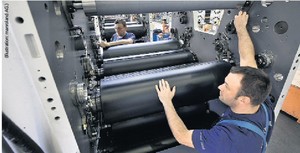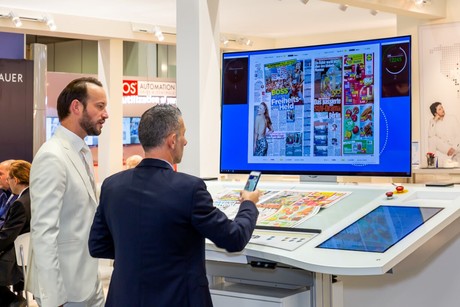The years of plenty are over for the press manufacturers. The changes in the media industry and the economic crisis have massively reduced the volume of the market for newspaper presses. There is a clear reluctance to invest in many of the developed markets; investments are practically nonexistent in the USA. The dramatic drop in turnover resulting from the falling-off in demand has compelled the newspaper press manufacturers to restructure, cut personnel and repeatedly introduce shorter working hours.
The consolidation in the newspaper area, predicted years ago by those in the know in the industry, began early in 2010 with the demise of Wifag (negotiations concerning a takeover by manroland had failed previously), continued with the takeover of Goss by Shanghai Electric shortly afterwards (May 2010) and about a year later (April 2011) caught up with Solna, which was then acquired by Wifag, which had in the meantime slimmed down and restructured.
Now manroland also has been sucked into the downward spiral. The number two in the newspaper area had come under even greater financial pressure than its main competitor, KBA, and the world market leader for presses, Heidelberger Druckmaschinen (though the latter has long since eliminated newspaper presses from its programme). On 25 November 2011 manroland finally was forced to file for insolvency after its main shareholder, ACP (75 percent) and former parent MAN (23 percent), declined to make available additional financial resources and an investor (the Swiss equity investment company, Capvis) opted out at the last minute.
Shortly before Christmas, some 6500 employees in Augsburg, Offenbach and Plauen feared losing their jobs. On 2 December the creditor bank granted a credit totalling EUR 55 million to ensure that business operations could continue. Thomas Hauser, responsible for marketing and communication at manroland, has assured the industry that business will continue as usual and that initially nothing will change for customers and business partners, also with regard to contacts. “The executive manager and provisional insolvency administrator will obtain a comprehensive impression of the situation and promptly examine the opportunities for a financial rescue,“ said Hauser. More detailed information about the situation and its expected effects was not available at the beginning of December 2011.
At the time of going to press, it was not yet established which of the possible scenarios could be realised for the rescue of the company. Major hopes are being set in the experienced insolvency administrator, Werner Schneider, who in earlier projects of this type successfully secured the continued trading of the businesses and the retention of a major share of the jobs. The following options are under consideration:
- complete takeover by an investor from outside the industry,
- complete takeover by a competitor, and
- splitting into web (newspaper) printing and sheet-fed offset divisions.
In the case of the last option, which is regarded as not improbable at this stage, competitors from the newspaper sector – possibly including foreign companies as well as manroland’s main competitor in Germany – might be interested in acquiring the web division to expand their market position. Some people in the industry are critical of the idea that the company should be kept alive, arguing that it would merely redistribute the existing overcapacities among a small number of players and render inevitable the next round of restructuring and cuts. Naturally, manroland customers take a completely different view. They want to see a continued market presence of their press supplier and know that they will be looked after. In addition to customers, the companies supplying manroland, e.g. in the area of automation, are also affected.
Manfred Werfel, Executive Director of the WAN-IFRA Competence Centre Newspaper Production, says: “After the insolvency filing became known, questions and statements from manroland customers reached us. The overall tone of the statements indicates a wish that the turbulences should be happily resolved and a lively competition be retained in the interest of market diversity. WAN-IFRA fully agrees with such wishes.”
---
What does the manroland situation say about the future of print and printing technology? We would be pleased also to publish your opinion on the latest developments in the industry. Simply email us your comments at: [reader@wan-ifra.org]




